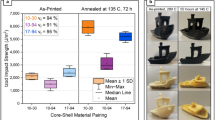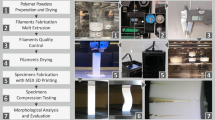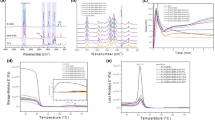Abstract
The goal of this work was to create shape memory polymer blends for the additive manufacturing technology of fused filament fabrication. An iterative approach was taken to develop a binary blend of polycaprolactone (PCL) and thermoplastic urethane (TPU). The composition of equal parts by mass PCL and TPU exhibited the best mechanical and shape memory properties. It was then decided to compound a ternary blend of PCL, TPU, and polylactic acid (PLA) where all components were of equal parts by mass. Constituents were chosen because they are all long chain polyesters with similar Hildebrand solubility parameters, because they are biocompatible, and because they all have some level of shape memory properties on their own. Dynamic mechanical analysis was performed to determine the recovery temperature for specimens that were deformed at room temperature. Scanning electron microscopy was used to perform fracture surface analysis of spent tensile test specimens. X-ray diffraction was used to explore aspects related to crystallinity of the blend materials. Transmission electron microscopy was used to characterize the mixing of the blend constituents where both the binary and ternary blends were found to be immiscible. The work presented here demonstrates materials selection based on structure, polymer family, and solubility parameter as a strategy for the development of multi-constituent polymer blends without the use of compatibilizers.
















Similar content being viewed by others
Data availability
Not applicable.
References
Avila JM, Cavender-Word TJ, Roberson DA (2023) Exploring the effect of moisture exposure on shape memory polymer performance. J Polym Environ. https://doi.org/10.1007/s10924-023-02818-w
Andrade Chávez F, Siqueiros JG, Carrete IA et al (2019) Characterisation of phases and deformation temperature for additively manufactured shape memory polymer components fabricated from rubberised acrylonitrile butadiene styrene. Virtual Phys Prototyp 14:188–202. https://doi.org/10.1080/17452759.2018.1550694
Delaey J, Dubruel P, Van Vlierberghe S (2020) Shape-memory polymers for biomedical applications. Adv Funct Mater 30:1909047. https://doi.org/10.1002/adfm.201909047
Sabahi N, Chen W, Wang C-H et al (2020) A review on additive manufacturing of shape-memory materials for biomedical applications. JOM 72:1229–1253. https://doi.org/10.1007/s11837-020-04013-x
Quiñonez PA, Ugarte-Sanchez L, Bermudez D et al (2021) Design of shape memory thermoplastic material systems for FDM-type additive manufacturing. Materials 14:4254. https://doi.org/10.3390/ma14154254
Cavender-Word TJ, Roberson DA (2023) Development of a resilience parameter for 3D-printable shape memory polymer blends. Materials 16:5906. https://doi.org/10.3390/ma16175906
Word TJ, Guerrero A, Roberson DA (2021) Novel polymer materials systems to expand the capabilities of FDM™-type additive manufacturing. MRS Commun 11:129–145. https://doi.org/10.1557/s43579-021-00011-5
Lendlein A, Langer R (2002) Biodegradable, elastic shape-memory polymers for potential biomedical applications. Science 296:1673–1676. https://doi.org/10.1126/science.1066102
Lai S-M, Lan Y-C (2013) Shape memory properties of melt-blended polylactic acid (PLA)/thermoplastic polyurethane (TPU) bio-based blends. J Polym Res 20:140. https://doi.org/10.1007/s10965-013-0140-6
Zhang H, Wang H, Zhong W, Du Q (2009) A novel type of shape memory polymer blend and the shape memory mechanism. Polymer 50:1596–1601. https://doi.org/10.1016/j.polymer.2009.01.011
Wang Y, Zhang J, Li M et al (2022) 3D printing thermo-responsive shape memory polymer composite based on PCL/TPU blends. J Polym Res 29:243. https://doi.org/10.1007/s10965-022-03095-2
Jing X, Mi H-Y, Huang H-X, Turng L-S (2016) Shape memory thermoplastic polyurethane (TPU)/poly(ε-caprolactone) (PCL) blends as self-knotting sutures. J Mech Behav Biomed Mater 64:94–103. https://doi.org/10.1016/j.jmbbm.2016.07.023
Xu X, Fan P, Ren J et al (2018) Self-healing thermoplastic polyurethane (TPU)/polycaprolactone (PCL) /multi-wall carbon nanotubes (MWCNTs) blend as shape-memory composites. Compos Sci Technol 168:255–262. https://doi.org/10.1016/j.compscitech.2018.10.003
Ho KG, Pometto AL, Gadea-rivas A et al (1999) Degradation of polylactic acid (PLA) plastic in costa rican soil and Iowa State University compost rows. J Environ Polym Degrad 7:173–177. https://doi.org/10.1023/A:1022874530586
Roberson DA, Rocha CR, Piñon M (2015) Evaluation of 3D printable sustainable composites. University of Texas at Austin
Myers D, Abdel-Wahab A, Hafeez F et al (2022) Optimisation of the additive manufacturing parameters of polylactic acid (PLA) cellular structures for biomedical applications. J Mech Behav Biomed Mater 136:105447. https://doi.org/10.1016/j.jmbbm.2022.105447
Bermudez D, Quiñonez PA, Vasquez EJ et al (2021) A comparison of the physical properties of two commercial 3D printing PLA grades. Virtual Phys Prototyp 16:178–195. https://doi.org/10.1080/17452759.2021.1910047
Carrete IA, Bermudez D, Aguirre C et al (2019) Failure analysis of additively manufactured polyester test specimens exposed to various liquid media. J Fail Anal Prev 19:418–430. https://doi.org/10.1007/s11668-019-00614-0
Aimar A, Palermo A, Innocenti B (2019) The role of 3D printing in medical applications: a state of the art. J Healthc Eng 2019:e5340616. https://doi.org/10.1155/2019/5340616
Ebrahimi F, Ramezani Dana H (2022) Poly lactic acid (PLA) polymers: from properties to biomedical applications. Int J Polym Mater Polym Biomater 71:1117–1130. https://doi.org/10.1080/00914037.2021.1944140
Pinto LA, Backes EH, Harb SV et al (2024) Shape memory thermoplastic polyurethane/polycaprolactone blend and composite with hydroxyapatite for biomedical application. J Mater Res 39:90–106. https://doi.org/10.1557/s43578-023-01172-w
Shin EJ, Jung YS, Park CH, Lee S (2023) Eco-friendly TPU/PLA blends for application as shape-memory 3D printing filaments. J Polym Environ 31:3182–3196. https://doi.org/10.1007/s10924-023-02799-w
Bhattacharya S, Hailstone R, Lewis CL (2020) thermoplastic blend exhibiting shape memory-assisted self-healing functionality. ACS Appl Mater Interfaces 12:46733–46742. https://doi.org/10.1021/acsami.0c13645
Rocha CR, Perez ART, Roberson DA et al (2014) Novel ABS-based binary and ternary polymer blends for material extrusion 3D printing. J Mater Res 29:1859–1866. https://doi.org/10.1557/jmr.2014.158
Quiñonez PA, Bermudez D, Ugarte-Sanchez L, Roberson DA (2019) Tailoring physical properties of shape memory polymers for FDM-type additive manufacturing. In: Solid freeform fabrication 2019: proceedings of the 30th annual inernational solid freeform fabrication symposium. TMS, Austin, TX USA, pp 843–855
Su S, Duhme M, Kopitzky R (2020) Uncompatibilized PBAT/PLA blends: manufacturability, miscibility and properties. Materials 13:4897. https://doi.org/10.3390/ma13214897
Adamska K, Voelkel A, Berlińska A (2016) The solubility parameter for biomedical polymers—application of inverse gas chromatography. J Pharm Biomed Anal 127:202–206. https://doi.org/10.1016/j.jpba.2016.04.014
Gallu R, Méchin F, Dalmas F et al (2020) On the use of solubility parameters to investigate phase separation-morphology-mechanical behavior relationships of TPU. Polymer 207:122882. https://doi.org/10.1016/j.polymer.2020.122882
Lares Carrillo L (2023) Additive manufacturing of binary and ternary shape memory polyester blends as a pathway towards high entropy polymer systems. Open Access Theses Diss
Zhou Y, Luo L, Liu W et al (2015) Preparation and characteristic of PC/PLA/TPU blends by reactive extrusion. Adv Mater Sci Eng 2015:1–9. https://doi.org/10.1155/2015/393582
Liu F, Vyas C, Poologasundarampillai G et al (2018) Structural evolution of PCL during melt extrusion 3D printing. Macromol Mater Eng 303:1700494. https://doi.org/10.1002/mame.201700494
ASTM (2014) ASTM D638-14: standard test method for tensile properties of plastics. ASTM
AMFG (2018) TPU 3D printing: A guide to 3D printing flexible parts. In: AMFG. https://amfg.ai/2018/07/23/tpu-3d-printing-guide/. Accessed 19 Mar 2023
Siqueiros JG, Roberson DA (2017) In situ wire drawing of phosphate glass in polymer matrices for material extrusion 3D printing. Int J Polym Sci 2017:e1954903. https://doi.org/10.1155/2017/1954903
Keusch S, Haessler R (1999) Influence of surface treatment of glass fibres on the dynamic mechanical properties of epoxy resin composites. Compos Part Appl Sci Manuf 30:997–1002. https://doi.org/10.1016/S1359-835X(99)00007-X
Shin BY, Han DH (2017) Viscoelastic properties of PLA/PCL blends compatibilized with different methods. Korea-Aust Rheol J 29:295–302. https://doi.org/10.1007/s13367-017-0029-8
Ahmed MF, Li Y, Yao Z et al (2019) TPU/PLA blend foams: enhanced foamability, structural stability, and implications for shape memory foams. J Appl Polym Sci 136:47416. https://doi.org/10.1002/app.47416
Han D, Chen G, Xiao M et al (2018) Biodegradable and toughened composite of poly(propylene carbonate)/thermoplastic polyurethane (PPC/TPU): effect of hydrogen bonding. Int J Mol Sci 19:2032. https://doi.org/10.3390/ijms19072032
Lares Carrillo LE, Salazar JF, Hitter MM et al (2023) The effect of raster pattern and acetic acid exposure on the mechanical and failure properties of additively manufactured PLA and PLA-wood composite specimens. J Fail Anal Prev 23:1298–1312. https://doi.org/10.1007/s11668-023-01681-0
Dave HK, Prajapati AR, Rajpurohit SR et al (2022) Investigation on tensile strength and failure modes of FDM printed part using in-house fabricated PLA filament. Adv Mater Process Technol 8:576–597. https://doi.org/10.1080/2374068X.2020.1829951
Roberson DA, Siqueiros JG (2016) Novel polycarbonate/SEBS-g-MA blend for FDM-type 3D printing. In: Annual technical conference-ANTEC. pp 10–14
Siqueiros JG, Schnittker K, Roberson DA (2016) ABS-maleated SEBS blend as a 3D printable material. Virtual Phys Prototyp 11:123–131. https://doi.org/10.1080/17452759.2016.1175045
Torrado AR, Roberson DA (2016) Failure analysis and anisotropy evaluation of 3D-printed tensile test specimens of different geometries and print raster patterns. J Fail Anal Prev 16:154–164. https://doi.org/10.1007/s11668-016-0067-4
Torrado AR, Shemelya CM, English JD et al (2015) Characterizing the effect of additives to ABS on the mechanical property anisotropy of specimens fabricated by material extrusion 3D printing. Addit Manuf 6:16–29. https://doi.org/10.1016/j.addma.2015.02.001
Perez ART, Roberson DA, Wicker RB (2014) Fracture surface analysis of 3D-printed tensile specimens of novel ABS-based materials. J Fail Anal Prev 14:343–353. https://doi.org/10.1007/s11668-014-9803-9
Yang WG, Lu H, Huang WM et al (2014) Advanced shape memory technology to reshape product design, manufacturing and recycling. Polymers 6:2287–2308. https://doi.org/10.3390/polym6082287
Li H, Gao Y, Zhao S et al (2022) Dual and triple shape memory properties of poly(ε-caprolactone)-based cross-linked polymer elastomers. Polym Test 115:107738. https://doi.org/10.1016/j.polymertesting.2022.107738
Tekay E, Şen S, Korkmaz MA, Nugay N (2023) Preparation and characterization of thermo-responsive shape memory ester-based polymer blends. J Mater Sci 58:8241–8260. https://doi.org/10.1007/s10853-023-08549-6
Borjigin M, Eskridge C, Niamat R et al (2013) Electrospun fiber membranes enable proliferation of genetically modified cells. Int J Nanomed 8:855–864. https://doi.org/10.2147/IJN.S40117
Biscaia SI, Viana TF, Almeida HA, Bártolo PJ (2015) Production and characterisation of PCL/ES scaffolds for bone tissue engineering. Mater Today Proc 2:208–216. https://doi.org/10.1016/j.matpr.2015.04.024
Hu H, Dorset DL (1990) Crystal structure of poly(iε-caprolactone). Macromolecules 23:4604–4607. https://doi.org/10.1021/ma00223a017
Tabi T, Sajo IE, Szabo F et al (2010) Crystalline structure of annealed polylactic acid and its relation to processing. Express Polym Lett 4:659–668. https://doi.org/10.3144/expresspolymlett.2010.80
Tábi T, Hajba S, Kovács JG (2016) Effect of crystalline forms (α′ and α) of poly(lactic acid) on its mechanical, thermo-mechanical, heat deflection temperature and creep properties. Eur Polym J 82:232–243. https://doi.org/10.1016/j.eurpolymj.2016.07.024
Farid T, Herrera VN, Kristiina O (2018) Investigation of crystalline structure of plasticized poly (lactic acid)/Banana nanofibers composites. IOP Conf Ser Mater Sci Eng 369:012031. https://doi.org/10.1088/1757-899X/369/1/012031
Baptista C, Azagury A, Shin H et al (2020) The effect of temperature and pressure on polycaprolactone morphology. Polymer 191:122227. https://doi.org/10.1016/j.polymer.2020.122227
Hu W (2018) The physics of polymer chain-folding. Phys Rep 747:1–50. https://doi.org/10.1016/j.physrep.2018.04.004
Acknowledgements
The work presented here was performed in the Polymer Extrusion Lab in the Department of Metallurgical, Materials and Biomedical Engineering (MMBME) at The University of Texas at El Paso (UTEP). The authors are thankful for the use of the XRD, TEM, and tensile tester available in the MMBME department. Funding was provided by the National Science Foundation (NSF) under grant number CMMI 2227573.
Author information
Authors and Affiliations
Contributions
Luis E. Lares Carillo fabricated specimens, performed experiments, compiled data, and wrote original manuscript. Yareli O. Gonzalez performed experiments, plotted data, and created figures. Marilyn Parga performed experiments and created figures. Katia Lizbeth Delgado Ramos performed experiments and compiled data. Nadya Neparko fabricated specimens and performed experiments. David A. Roberson conceptualized experiments, performed cryo-ultramicrotomy and TEM analysis, and compiled final manuscript.
Corresponding author
Ethics declarations
Conflicts of interest
The authors declare no conflicts of interest.
Ethical approval
Not applicable.
Additional information
Handling Editor: Jaime Grunlan.
Publisher's Note
Springer Nature remains neutral with regard to jurisdictional claims in published maps and institutional affiliations.
Rights and permissions
Springer Nature or its licensor (e.g. a society or other partner) holds exclusive rights to this article under a publishing agreement with the author(s) or other rightsholder(s); author self-archiving of the accepted manuscript version of this article is solely governed by the terms of such publishing agreement and applicable law.
About this article
Cite this article
Carrillo, L.E.L., Gonzalez, Y.O., Parga, M. et al. Development of binary and ternary polyester shape memory blends for additive manufacturing. J Mater Sci 59, 8040–8057 (2024). https://doi.org/10.1007/s10853-024-09657-7
Received:
Accepted:
Published:
Issue Date:
DOI: https://doi.org/10.1007/s10853-024-09657-7




